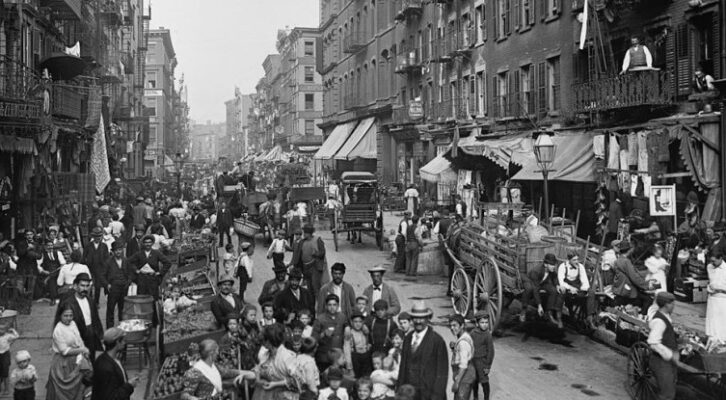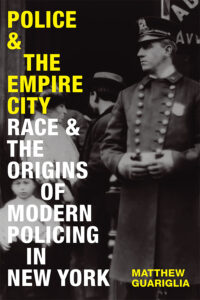
How the NYPD Attempted to Navigate Cultural and Linguistic Barriers in the Early 20th Century
Matthew Guariglia on the Challenges of Urban Policing
One of the biggest challenges for the NYPD, especially in the years following the turn of the twentieth century, was policing the newcomer immigrants settling throughout Downtown Manhattan. These communities became sites where the NYPD eagerly attempted to recruit informants, and eventually, officers as a way to make up for the existing department’s lack of language skills or cultural knowledge. With the exception of the formalized ethnic squads, created and deployed as specific forces to police immigrant neighborhoods in the opening years of the twentieth century it is unclear if there was ever a specific written directive to diversify the department. No memoranda survive directing recruitment priorities or altering civil service exams to make them more accessible to multi-lingual officers. However, it is clear from the writings of police administrators as well as the number of high-profile immigrant officers regularly reported on in the press, that during those years the NYPD dedicated a considerable amount of resources to developing a model for policing immigrant neighborhoods.
The language barrier in New York was becoming an increasing hurdle for the criminal justice and judicial system.
White politicians, police, and social scientists alike agreed that, while immigrant crime and the subordination of immigrant neighborhoods was an administrative challenge—it was a challenge that could, at least theoretically, be solved. White immigrant crime, especially attributed by police to large and growing Italian and Jewish neighborhoods, and to a somewhat lesser extent Chinese community, was not inevitable. It could be solved and crime could be eradicated by a coercive combination of Americanization, pacification, surveillance, and proactive policing. To this extent, the police department dedicated a large amount of resources in the year between 1903 and 1910 to infiltrating, surveilling, and forcibly policing immigrant neighborhoods. Francis Vinton Greene’s successor as police commissioner, former Assistant Secretary of the Navy William McAdoo, saw immediately upon taking the post that the “closeness of the living quarters, the narrowness of the streets, and the mixture of races,” made the densely-packed and diverse immigrant neighborhoods, “the most complex and difficult police problem of any similar place on Earth.” He firmly believed that this “problem” could be solved by assimilation and more thoughtful policing. He wrote that if an intelligent foreigner or a curious rural American wanted to see “how under American laws and customs we assimilate and make over the raw foreigner, or even the semi-barbarous alien…” they need only venture down to the Lower East Side to see how “the educational process goes on steadily, and the police as a general rule are tolerant and show intelligence in handling these masses.” There is ample evidence that police were not always as thoughtful and helpful in their dealings with immigrants. After all, McAdoos’s assertion that the “police must study these people, their habits, customs, ideas and somewhat of their history…” did make a substantial impact on how police deployed detectives into some neighborhoods—but was not at all incompatible with a style of policing that involved heavy use of the club and arbitrary arrests.
When American-born police arrested immigrants, criminal trials were often fraught with miscommunication, over-reliance on translators, and attempts on the part of police to wrap up speedy convictions by taking advantage of the defendant’s lack of English-language skills or knowledge of the U.S. legal system. For instance, in 1910 when police arrested Francesco Sansone for the murder of a friend and fellow Italian immigrant, arresting officer Frances McGee told the court of Sansone’s confession. The officer recalled the defendant saying, “Me no afraid, I shoot the son-of-a-bitch, he all the time make trouble for me and I can no longer stomach him.” But when Sansone himself took the stand, aided by an Italian translator, he claimed he could speak no English at all—let alone speak in colloquialisms like “son-of-a-bitch” or “no longer stomach him.” It is possible that immigrants on the stand had the ability and willingness to retreat into feigned ignorance and accentuate their foreignness in an attempt to subvert police narratives and avoid conviction. It is also true that police could have very likely invented English-language confessions like the one attributed to Sansone to speed up trials and ensure timely convictions.
Whether police or immigrants took advantage of their foreignness as a way to obscure the truth, one thing was certain: the language barrier in New York was becoming an increasing hurdle for the criminal justice and judicial system. The rising need for translators in courtrooms, as well as on the streets, also had an impact on the administration of justice. Even in instances where foreign-born or first-generation translators were called in to analyze the testimony of the accused and witnesses, their interpretations and cultural knowledge were often held as suspect or unintelligible to an all-American, all-male jury. In the 1911 trial of Chinese-born man Leon Jung for running a gambling ring, the prosecution called Quan Yick Nam, a California-born and bilingual interpreter and regular police informant to translate papers found in Chinatown Jung’s office.
A new model of policing and adjudication had to consolidate quickly in order to effectively manage the diversifying city.
In hopes that a piece of paper taken into evidence included a list of people who had placed bets, Yick Nam corrected the cross-examiner. “Chow Lee” he said, maintained the naming convention of a firm or company, rather than an individual. “Objection,” cried an attorney. He maintained that the naming convention “John Smith,” similar to “Chow Lee,” would clearly be an individual’s name and contested the translator’s interpretation as speculation. The courtroom often became a site where different types of knowledge about culture and language came into conflict.
Judges in these two cases both seemed acutely aware of the impact that both the need for translators, as well as prevailing prejudices and stereotypes about immigrants in the city might have on juries deciding the cases. In Sansone’s case, the judge warned about the complications that might arise when English-speaking police interface with translators, “I think it is only fair to the witness and the defendant to say,” said the judge, “that the statements concerning which this witness is now being examined are supposed to have been made some time since the charge here, but this witness, in Italian to an officer. That officer then translated the alleged statement made by this man into English, and it was typewritten, and now another Italian interpreter is taking that statement out of that translation and putting the questions to this man. I say that to you so that you may have a fair notion of the value, as evidence, of a contradictory statement proved from that sort of transaction.” It was very easy for contradictions in stories that seemed pertinent to the case and meaningful for assessing guilt could arise from the retelling of the story multiple times in multiple languages.
In Leon Jung’s case, Judge O’Sullivan warned the jury that they had to, in pursuit of justice, leave behind their larger feelings about Chinese people and their immigration to the United States. “You gentlemen are to look into this case as I know you will, absolutely divested of any prejudice toward the defendant in this case or towards his people. You are not on account of certain suggestions that we cannot reach the Chinese by our law as it exists to endeavor to apply the law to this defendant simply for that purpose, because they are as much entitled to the protection of our law as any people living under it.” Both on the street and in courtrooms—for reasons of justice and effective pacification—a new model of policing and adjudication had to consolidate quickly in order to effectively manage the diversifying city.
__________________________________

Excerpted from Police and the Empire City: Race and the Origins of Modern Policing in New York by Matthew Guariglia. Copyright © 2023. Available from Duke University Press.
Matthew Guariglia
Matthew Guariglia is Affiliated Scholar at the University of California College of the Law, San Francisco, Senior Policy Analyst at the Electronic Frontier Foundation, and coeditor of The Essential Kerner Commission Report.



















